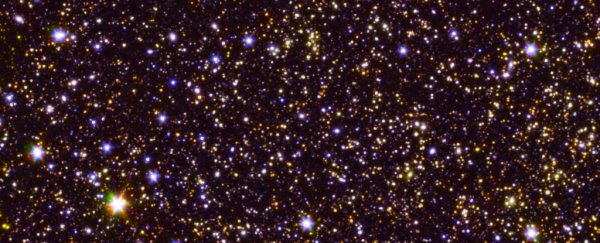The Universe didn't begin as we see it today, glittering with light. For the first 500 million or so years, it was a murky, neutral hydrogen-filled darkness. Then something started exciting the hydrogen with radiation, ionising it - and lo, there was light.
We don't know what ultimately caused that first ultraviolet light to shine. But new observations from NASA's Spitzer infrared space telescope have just given us a pretty significant clue. In the far reaches of the early Universe, it spied strange galaxies that are far more luminous than expected.
Piecing together those early years has been pretty difficult, but the timeline of the Epoch of Reionisation, as it is known, is pretty well established.
Just after the Big Bang, the Universe was a sort of dark, hot 'primordial soup' on a cosmic scale, rapidly expanding.
As the Universe expanded, it cooled, causing protons and neutrons to start to combine into ionised hydrogen atoms. Around 240,000-300,000 years after the Big Bang, these hydrogen atoms attracted electrons, coalescing into neutral hydrogen.
But it wasn't until gravity started to pull together the first stars and galaxies in this murky, hydrogen-filled void that starlight appeared, when ultraviolet, gamma and X-rays began colliding with the neutral hydrogen, stripping it of electrons and ionising it.
By 1 billion years after the Big Bang, the Universe was transparent and sparkling.
But how? Given all the neutral hydrogen in the Universe at this point, it would have taken a huge amount of radiation to make light, and it's unclear just what might have existed in sufficient abundance to produce such radiation. Would newborn stars have sufficed? Luminous galaxies? As-yet undetected quasars, or a combination of all three?
"It's one of the biggest open questions in observational cosmology," said astronomer Stephane De Barros of the University of Geneva. "We know it happened, but what caused it? These new findings could be a big clue."
In a special observation run to try and find the answer, Spitzer spent hundreds of hours staring at two separate regions of the night sky. Over 13 billion light-years away - just 730 million years after the Big Bang - it observed 135 galaxies that were very different from those closer to us.
 (NASA/JPL-Caltech/ESA/Spitzer/P. Oesch/S. De Barros/I.Labbe)
(NASA/JPL-Caltech/ESA/Spitzer/P. Oesch/S. De Barros/I.Labbe)
Above: Deep-field view of the sky showing faint, distant galaxies circled in red. Inset shows the light collected from a faint galaxy during a long-duration observation.
As expected from galaxies in the early Universe, they are very poor in heavy elements, which are forged in explosive processes and therefore weren't around in huge amounts until a few generations of stars had lived and died.
Instead, these galaxies are dominated by young, hot massive stars mostly made of hydrogen and helium - although traces of heavier elements indicate that they weren't the Universe's first generation of stars.
The galaxies are particularly bright in two infrared wavelengths that are produced by the interaction between ionising radiation and hydrogen and oxygen gases. These galaxies could have contributed to the Epoch of Reionisation.
"For over 10 years, we have been studying with Hubble and Spitzer some of the earliest and most distant galaxies known," said astronomer Garth Illingworth of UC Santa Cruz.
"Our latest Spitzer result reveals how different these early galaxies are to those at later times and pinpoints our sample as a key set for providing insights into how galaxies so efficiently reionised the Universe."
Of course, those other factors - individual stars, incredibly bright quasars - may have contributed too. The Epoch of Reionisation wasn't just a single event and then BOOM, light was there; it was more like the slow lifting of a curtain, a process that took place over hundreds of millions of years. So it's likely there was more than one factor involved.
The Spitzer space telescope launched in 2003, and has made amazing strides in infrared astronomy. NASA's next infrared telescope, WFIRST, is currently in development, with a planned launch date sometime in 2025.
One of its core missions is absolutely to try and shed further light on the Epoch of Reionisation, since many of those early Universe galaxies are strongest in infrared wavelengths. But the James Webb Space Telescope, Hubble's successor, will be taking a crack at it too.
"These results by Spitzer are certainly another step in solving the mystery of cosmic reionisation," said astronomer Pascal Oesch of the University of Geneva.
"We now know that the physical conditions in these early galaxies were very different than in typical galaxies today. It will be the job of the James Webb Space Telescope to work out the detailed reasons why."
The research has been published in the Monthly Notices of the Royal Astronomical Society.
